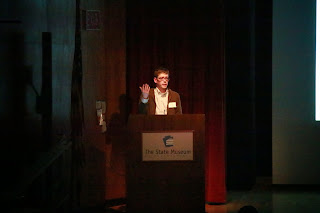With the Thanksgiving Holiday once again upon us TWIPA
returns this week with a post focused on one of everyone’s favorite topics, food.
Foodways, or subsistence strategies, have long been a topic of interest and
study of anthropologist and archaeologists. By quantifying the number and types
of food remains, archaeologists can determine the percentage of different types
of plants and animals harvested.
The State Museum of PA’s Section of Archaeology receives a
steady flow of artifact collections as a result of Cultural Resource Management
project surveys and excavations. A
recently submitted project involving highway improvements in Montgomery and Philadelphia
Counties recorded four dozen, mostly 19th Century domestic sites. As
a part of the project’s phase II workplan, diet and consumer behavior were
identified as potential research issues for two of the sites that were
considered potentially significant.
typical project area view, with orange flags marking shovel test pit locations
In his report to
PennDoT, Gary Coppock, working at the time for Archaeological & Historical
Consultants, noted, “Archaeological remains can be analyzed for indications of
the patterns of purchasing and consumption of goods by site occupants. Analysis
of faunal remains may show the extent to which wild or domestic animals
contributed to the diet, whether the animals were slaughtered at the site, and
the economic and dietary value of meats consumed by site occupants (Coleman et
al. 1984). Ceramic analyses can also contribute to the understanding of food
consumption habits. A comparison of the relative frequency of flatware and
hollowware forms, for example, has been used to infer the quality of meats used
and in what form they were consumed (Kelso 1984)."
Excavation Unit profile from Woodhaven Road Extension Project
Stepping back in time, the evolution of
foodways began with small populations of Paleoindian hunters and gatherers
exploiting an ice age landscape. Although the quantity of foods was relatively
low, human population was also low and they did not need to develop special
tools or organize a labor force to support themselves. The Archaic Period
represents a plentiful time and human populations quickly grew by efficiently
using all available resources. People developed many new tools to maximize
their collection of food from the environment. As human populations increased,
they began to exhaust the foods of the temperate forest and were forced to
cultivate plants.
Native American
social organization began to change. Humans became more sedentary and
eventually focused on farming to support increasing populations. Social
structure changed to a tribal organization in order to better organize the
labor force necessary for swidden agriculture of corn, beans and squash, often
referred to as the Three Sisters. Both the nature and timing of the arrival of
these domesticates into the Mid-Atlantic region continue to be intensively
studied research topics in archaeology.
Each of the “Sisters” arrived in the Northeast at different
points in time, with squash (Cucurbita
pepo) being the earliest at between 5000 and 2500 years before present
(Hart and Sidell 1997). Next, corn, or
maize, (Zea maize) becomes common in
archaeological settings post-dating roughly 1200 B.P., or about A.D. 700 (Klein
2003). And last to appear in the
archaeological record is the common bean (Phaseolus
vulgaris), at approximately A.D. 1300 (Hart and Scarry 1999). The
application of C-14 and AMS
techniques has proved to be indispensable tools for dating these and a wide
variety of other botanical remains.
Requiring magnification, smaller evidence such as pollen,
starch grains, and phytoliths can be used to identify plant species beyond the
three typical domesticates. These types of analyses can not only help to
identify dietary components of an archaeological site, but also aid more
broadly in paleoenvironmental reconstruction.
Along with zooarchaeological
analysis of faunal remains, proteins recovered from the residue on cookware can
be analyzed to identify groups of animal species and in some instances specific
species. All these techniques aid the archaeologist in creating a more detailed
picture of the past, in this case concerning just exactly what ingredients were used in
preparation of a meal.
We hope this brief overview of foodways and food remains
analysis wets your appetite for an enjoyable Thanksgiving meal with family and
friends.
References:
Coleman, Ellis C., Kevin W. Cunningham, Jim O’Connor, Wade
P. Catts, and Jay F. Custer
1984 Phase III Data Recovery Excavations of the
William M. Hawthorn Site (7NC-E-46), New Churchman’s Road, Christiana, New
Castle County, Delaware. Delaware Department of Transportation
Archaeological Series No. 28, Dover.
Coppock, Gary F.
2002 Phase I and II
Archaeological Survey Report Woodhaven Road Extension Project (S.R. 0063
Sections A06 & A07) Montgomery and Philadelphia Counties, Pennsylvania - prepared for the Pennsylvania Department of
Transportation Engineering District 6-0
Hart, John P. and C. Margaret
Scarry
1999 The Age of Common Beans
(Phaseolus vulgaris) In the Northeastern United States. American Antiquity
64 (4) 653- 658
Hart, John P. and Nancy Asch
Sidell
1997 Additional Evidence for Early
Curcurbit Use in the Northern Eastern Woodlands East of the Allegheny Front. American
Antiquity 62 (3): 523-537
Kelso, William M.
1984 Kingsmill
Plantation, 1617-1800: Archaeology of Country Life in Colonial Virginia.
Academic Press, New York.
Klein, Michael
2003 Of
Time and Three Rivers: Comments on Early and Middle Woodland Archaeology in
Pennsylvania. In Foragers
and Farmers of the Early and Middle Woodland Periods in Pennsylvania, edited
by Paul A. Raber and Verna L. Cowin, pp. 117-129. Recent Research in
Pennsylvania Archaeology, No.3, Pennsylvania Historical and Museum Commission,
Harrisburg, PAFor more information, visit PAarchaeology.state.pa.us or the Hall of Anthropology and Archaeology at The State Museum of Pennsylvania .














































